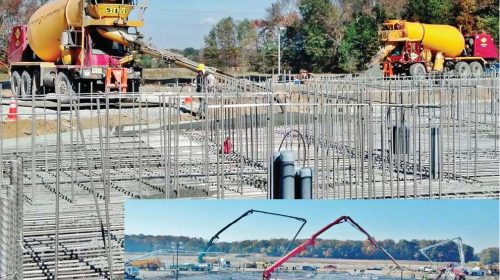Silvi Concrete neared the 2013 season close mustering almost its entire payroll for a weekend pour. The project entailed a 49,000-sq.-ft. foundation, 3-ft. thick, for a monument joining a recreational facility and temple in Robbinsville, N.J., built by BAPS, a worldwide Hindu organization.
In order to complete the monolithic placement per engineers’ specification, Fairless Hills, Pa.-based Silvi Concrete committed to delivering 600 yd. per hour over a 12-hour window. The producer lined up 108 mixer trucks and dedicated its central mixed plants in Elizabethton, Pa., plus Brick and Morristown, N.J.
| The BAPS monument foundation was built with stainless steel reinforcement and a high performance, fly ash-rich mix. |
Since the mix contained almost as much fly ash as portland cement, Silvi needed to stockpile the former material for weeks in portable blimps to ensure adequate quantities on hand. Looking immediately past the BAPS pour, the producer also had to amass enough stone, sand and cement for the first of the week.
The late-October pour started at 5:45 a.m., with the first trucks feeding five pumps strategically staged around the foundation. In order to reduce truck waiting time, Silvi arranged with the contractor to have areas between the pumps where mixers could dump directly into the foundation form.
After the first hour, 748 yd. had been placed; as noon approached, volume placed had reached 3,500 yd. Silvi was prepared for most any contingency on the heels of countless hours of meetings to discuss possible problems and troubleshooting. Among precautions: Mechanics with fully stocked repair trucks manned the site in the event of a mixer or pump breakdown. A full crew of mechanics likewise staffed the Elizabethton, Brick and Morristown plants.
In addition, an emergency fourth batch plant was open and ready to load in the event one of the primary plants went down. Yard team members were quick to refuel returning trucks, while managers guided mixer traffic at the three plants. Rounding out the staff mobilization were 20 employees at the site charged with quality control, traffic management and mixer staging. Silvi principals and senior managers helped expedite concrete flow by placing chute extensions at pump or direct discharge points. “A complete effort from everyone involved allowed this pour to go perfectly,” affirms Laurence Silvi II, president.
The last truck discharged into the foundation form shortly after 7 p.m., culminating in a 7,030-yd. pour without interruption. It was the largest single pour in Silvi Concrete’s history and one of it biggest accomplishments.
 PARKING LOT PROMOTION PAYS
PARKING LOT PROMOTION PAYS
Silvi Concrete proved throughout the prime 2013 construction season how premium concrete pavement parking lots can be delivered at initial cost comparable to asphalt alternatives. In less than six months, the producer was able to convert 1million sq. ft. of asphalt pavement to concrete, netting 20,000 yd. of ready mixed orders. It also helped peers outside its Pennsylvania and New Jersey service areas realize 32,000 yd. in additional ready mixed deliveries for 1.7 million sq. ft. of concrete pavement that would otherwise have been asphalt.
“Concrete parking lots should be one of the top priorities for all ready mixed producers throughout the country in 2014,” says Silvi New Jersey Regional Sales Manager Zach Rich. “The ready mixed business tends to be reactionary in nature. We wait for someone to call when they need concrete. This trend needs to change. The parking lot market is an untapped resource for producers nationwide.”
Silvi is bridging the concrete pavement knowledge and automation gap job by job and for each owner, general contractor, engineer, and concrete contractor involved. In the case of Campbell Freight, which was building an 80,000-sq.-ft. facility along the New Jersey Turnpike, Silvi prepared a concrete parking lot bid package against the asphalt pavement specified. Design-build contract terms invited value engineering as the project progressed; while Campbell Freight officials wanted a concrete parking lot, they didn’t feel it would fit within their budget.
A review of project drawings revealed over-design of the concrete pavement alternative. It prompted Rich to turn to the National Ready Mixed Concrete Association’s Design Assistance Program and concrete pavement online classes, plus ACI 330 R08–Concrete Parking Lots and 330.1-03–Unreinforced Concrete Parking Lots as references to support a proposed asphalt-to-concrete change based on comparable engineering properties. The concrete proposal prevailed, adding 6,000 yd. of ready mixed to the 2,000 yd. Silvi logged for the building.
During parking lot construction, the general contractor observed concrete crews’ use of 3D grading and laser screed equipment, imparting automation and accuracy to labor-intensive processes. Once the 3D profiler screeded the slab to desired height, crews bull floated the lot and finished it with a broom texture applied via a “kite” method. The Campbell Freight general contractor proposed a concrete parking lot with similar practice on its next project, which totaled 14,000 yd. of ready mixed and 725,000 sq. ft. of pavement.
